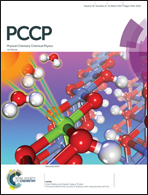An sd2 hybridized transition-metal monolayer with a hexagonal lattice: reconstruction between the Dirac and kagome bands†
Abstract
Graphene-like two-dimensional materials have garnered tremendous interest as emerging device materials due to their remarkable properties. However, their applications in spintronics have been limited by the lack of intrinsic magnetism. Here, we perform an ab initio simulation on the structural and electronic properties of several transition-metal (TM) monolayers (TM = Cr, Mo and W) with a honeycomb lattice on a 1/3 monolayer Cl-covered Si(111) surface. Due to the template effect from the halogenated Si substrate, the TM-layers will be maintained in an expanded lattice which is nearly 60% larger than that of the freestanding case. All these isolated TM-layers exhibit ferromagnetic coupling with kagome band structures related to sd2 hybridization and a strong interfacial interaction may destroy the topological bands. Interestingly, the W-monolayer on the Cl-covered Si substrate shows a half-metallic behavior. A Dirac point formed at the K point in the spin-down channel is located exactly at the Fermi level which is crucial for the realization of a quantum spin Hall state. Moreover, the reconstruction process between the Dirac and kagome bands is discussed in detail, providing an interesting platform to study the interplay between massless Dirac fermions and heavy fermions.



 Please wait while we load your content...
Please wait while we load your content...